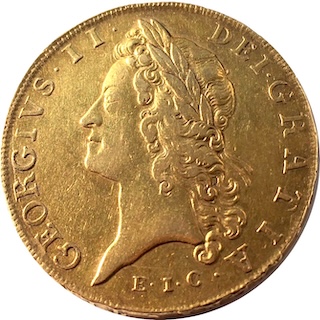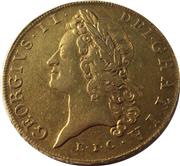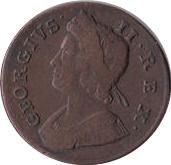
 1729 Five Guinea EIC - George II
1729 Five Guinea EIC - George IIThe 1729 Five Guinea EIC is a British Gold Coin minted under the reign of George II from gold bought from the East India Company.
Guineas got their name because the gold used to mint them came from Guinea in West Africa. Over the years gold came from other sources too and the Royal Mint started a practice of acknowledging the source of the gold by writing it under the King's head. 'LIMA' was used for gold captured from Spanish ships and 'E.I.C' was gold that came from the East India Company. The Five Guinea coin was the largest of the coins that bear the E.I.C. mark and although the actual mintage is not known it is a classed as a rare coin.
 The East India Company was also known as the British East India Company and informally as the John Company. It was founded in London in 1600 by John Watts and George White as a company to trade in the East Indies (today's Southeast Asia) but it traded with India, China and most of the Indian subcontinent.
The East India Company was also known as the British East India Company and informally as the John Company. It was founded in London in 1600 by John Watts and George White as a company to trade in the East Indies (today's Southeast Asia) but it traded with India, China and most of the Indian subcontinent.The East India Company's might grew to account to half the World's trade, with commodies like cotton, silk, salt, tea, saltpetre and opium. EIC helped build the British Empire in India, and was aggressive with it. By 1800, it had a private army of 260,000 men, which was twice as big as the British Army.
EIC effectively ruled India from 1757 until 1858, not always with financial gains. In 1857 the Indians had had enough and the Indian Rebellion of 1857, although not greatly sucessful in its own right, led to the British Government blaming and then nationalising the East India Company and bringing India under direct rule with a British Raj. Their armies were merged into the British Army and the company was officially dissolved in 1874.
Mintage: Not known
Minted at The Royal Mint
Below are some coins currently being offered on eBay. As an eBay Partner, We may be compensated if you make a purchase.
 George II was King of Great Britain and Ireland, Duke of Brunswick-Lüneburg and Prince-elector of the Holy Roman Empire from 11 June 1727 until his death. He was son of George I.
George II was King of Great Britain and Ireland, Duke of Brunswick-Lüneburg and Prince-elector of the Holy Roman Empire from 11 June 1727 until his death. He was son of George I.George was the last British monarch to be born outside Great Britain; he was born in Germany. There were a few arguements about various claims to the throne and not all of George's family supported him. George's eldest son Frederick died in 1751 and George was eventually succeeded by his grandson, George III.
The regnal years for George II coins were:
1729:TERTIO; 1731:QVARTO; 1735:OCTAVO; 1738:DVODECIMO; 1741:DECIMO QVARTO; 1746:DECIMO NONO; 1748:VICESIMO SECVNDO; 1753:VICESIMO SEXTO.
The Guinea is a famous British gold coin minted between 1663 and 1814. The coin was originally created as a one pound coin (20 shillings) but is better known as being worth One Pound and One Shilling (21 shillings).
After the English Civil War, King Charles II introduced new coinage. A gold coin, approximately a quarter of an ounce, was issued and for the first time it was not hammered. Made by machine using gold from the Guinea Coast of West Africa the coin probably became the most important coin of the realm.
Originally 20 shillings, the coin actually fluctuated with the gold price, at times being as high as 30 shillings. In 1717 the Guinea became fixed at 21 shillings (in today’s money that is £1.05). Other coins of the family were also minted, such as half-guinea, two-guinea and five-guinea.
The design of gold guinea changed dramatically over the years, from depictions of crowned cruciform shields to the ‘Spade’ shaped crowned shields of arms.
In the Great Recoinage of 1816 the Guinea was replaced by the Pound and the Sovereign became the gold coin in use. The last guinea was issued during the reign of King George III in 1813. That particular coin is known as a ‘Military’ guinea, as it was specially struck to pay British troops at the time of the Napoleonic Wars.
Long after the Guinea was retired the name continued to be used, especially for prestige purchases intended for the more wealthy. Even now racehorses are still sold in Guineas (the auctioneer traditionally taking the 5p as commission).
Guineas are 25mm in diameter, weigh about 8.38g and are 22 carat gold (91.6%). Prior to 1717 they weighed slightly less (around 8.3g) and were made of 91.34% gold.
Millions of gold guineas were minted and widely circulated, so often turn up in fine to very fine condition. As with all coin types, some years are much rarer than others, such as the 1761 guinea (as it was the first guinea minted during the reign of King George III).
Formed in the reign of Alfred the Great about the year 886, during the period 1279-1812 it was generally referred to as The Tower Mint as it was housed at the Tower of London. The Master of The Royal Mint has included famous figures such as Sir Isaac Newton.
Since 2010 it has operated as Royal Mint Ltd, a company owned by HM Treasury, under an exclusive contract to supply all coinage for the UK although it also produces medals and coins for other countries. It is currently located at Llantrisant, Wales.
The orignal coinage was Pounds, Shillings and Pence but since decimalisation on 15 February 1971, it is £1 = 100p, that is One Pound = 100 pence. The coinage of the UK is also a long history, the Royal Mint being established as long ago as 886AD when coins were hammered. Today there is perhaps 30 billion coins in circulation, and many (numismatic) collectors coins and sets are issued frequently in gold, silver and other metals.








